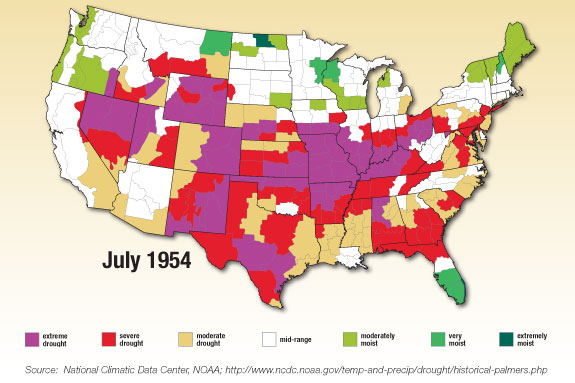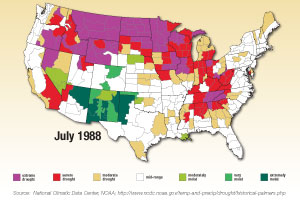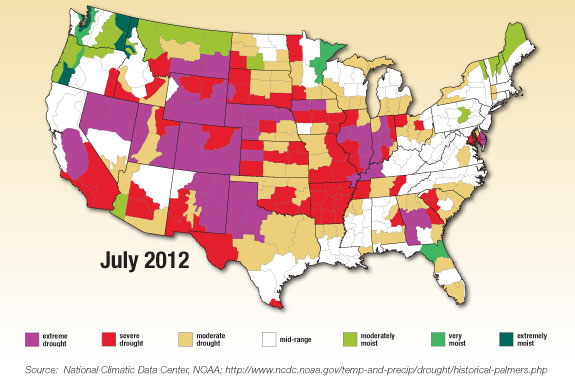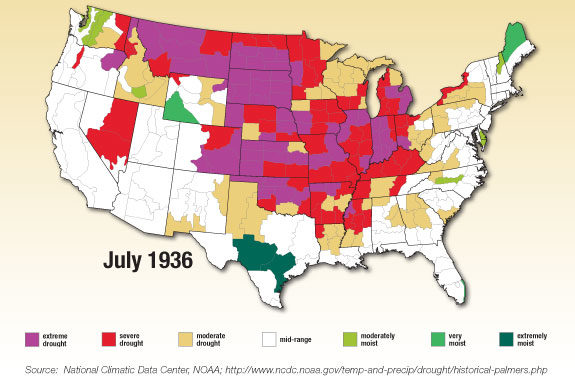The stressful growing condition much of the country is currently experiencing is the fourth time agriculture has been devastated by drought in the last 100 years. Most of us have at least seen documentaries or read John Steinbeck’s novel The Grapes of Wrath, about the Dust Bowl. This seven-year drought affected much of the U.S., with 1934, 1936 and 1939 being the most devastating years.
Computer simulations indicate the length of the drought was not only the result of ocean temperature patterns but also due to the loss of prairie vegetation and dust blocking sunlight and creating high pressure zones of sinking air which discouraged precipitation. Poor soil management practices coupled with depleted soil moisture resulted in clouds of topsoil so thick that they reportedly hid the sun for days on end.
Many farmers did whatever it took to increase farm yields in an attempt to recover from losses incurred in the Great Depression. This included farming highly sensitive ground with minimal concerns for the future of the land. Prairie grass which had evolved natural resistance to drought was widely replaced with drought-sensitive wheat.
However, the Dust Bowl taught us cultivation methods and soil erosion control lessons which have lessened the environmental impact of subsequent droughts.
These lessons included retiring sensitive, highly erodible ground in set-aside programs, understanding the importance of cover crops and eventually leading to the development of now-common cultural practices, such as no-till seeding.
The next widespread drought occurred from 1950 to 1955 and can be remembered by our more senior agriculturists. It was first felt in the southwest U.S. but, by 1954, had spread to a 10-state area as far east as central Nebraska. This drought was characterized by lack of water and excessively high temperatures.
Crop yields were reduced by more than 50 percent and destroyed grazing ground. Reports are that hay prices became so costly that some ranchers fed cattle a mixture of prickly pear cactus and molasses. The drought of the ’50s is very similar to our current drought experience due to the effect of high heat and lack of rain.
This is devastating to both the health and reproduction of livestock and to the crops growing in the field.
The current price of grain and forages is even more dynamic today due to the competition for corn and corn acres from ethanol, which was not an economic force in the ’50s.

The drought of 1987 to 1989 is still well etched in the minds of many producers still actively farming today.
The ’80s drought covered about 36 percent of the U.S. compared to 70 percent with the Dust Bowl. Even though fewer acres were impacted, it is considered the most costly natural disaster to hit the U.S. because of the effect it had on key corn and soybean areas, where total precipitation for April through June of 1988 was even lower than during the Dust Bowl.
The drought of 2012 is somewhat similar to 1988 in terms of its relatively rapid onset. However, climatologists are predicting it will not have the long-term persistence seen with the Dust Bowl or ’50s droughts. La Niña (lower Pacific Ocean temperatures) played a role in previous droughts – but weather experts are now seeing a move to an El Niño sometime this fall. This will hopefully be good news, as multiyear droughts typically require a persistent El Niño or La Niña.
The 2012 growing season is a harsh reminder of the economic realities of drought and the vulnerability many livestock operations have not experienced since 1987-1989. About the only good news is that, just like agronomic lessons that were learned during the Dust Bowl, we have advanced in science and lessons from the late ’80s which can benefit us today.
The feeding value of drought-stressed forages
In the ’80s drought, most concern was about nitrates and mycotoxins – especially aflatoxin. We still have nitrate and possibly aflatoxin issues, but the access to management options is much more readily available today than it was in 1988.
This is primarily due to the speed at which we have become accustomed to receiving and processing information. One only has to conduct a Web browser search and you will find helpful information on these topics on dozens of websites or in YouTube videos.
Aflatoxin continues to be a major concern to the dairy industry because lactating cows that eat feed containing 20 ppb or greater aflatoxin may produce milk that exceeds the tolerance level for this contaminant. It usually takes two to three days on an aflatoxin-free diet for milk concentrations to fall below tolerance levels.
Aflatoxin is produced by aspergillus molds, which grow most profusely in drought-type conditions. Aflatoxin is among the most carcinogenic substances known to man and levels are strictly monitored by the FDA to assure consumers less than 0.5 ppb is present in milk.
We also better understand today that it is better to feed drought-stressed crops as silage rather than green-chop or hay because fermentation typically reduces plant nitrate levels by approximately 30 to 50 percent. The potential for high nitrate levels occurs when crops such as corn, sorghum and some grasses are exposed to stress situations, including drought.
Corn accumulates toxic nitrate concentrations in the lower portion of the stover when crop yield is less than the supplied nitrogen fertility level and when reduced plant biochemical functions impede nitrogen from being converted to crude protein in the kernel. When high-nitrate forages are fed to livestock, they can induce symptomatic labored breathing, interfering with the blood’s ability to carry oxygen.

As a general recommendation, feeding programs should be modified if post-fermented silage contains more than 1,000 ppm of nitrate-nitrogen.
Fermentation typically reduces plant nitrate levels by approximately 30 to 50 percent. Drought or stressed silage should ferment a full three weeks before feeding, particularly if not inoculated.
Fermentation bacteria reduce the nitrate to gaseous forms (silo gas), which can be deadly if inhaled.
These gases are heavier than air and accumulate in tower silo feeding rooms or at the base of bunker-walled silos where minimal air flow exists. Ruminants can be fed higher-nitrate feeds if the rumen bacteria are given time to adapt by gradually increasing the volume of high-nitrate feed in the ration and if cattle are fed more frequently than normal.
Problems also can be reduced by diluting the stressed silage with other feeds and avoiding the use of non-protein nitrogen sources, such as urea or ammonia. If the crop has been stressed or shows a marked reduction in grain content, nitrate analysis is recommended, which is inexpensive and routinely available at most commercial laboratories.
New technologies to the rescue
Today, we have a much more sophisticated laboratory infrastructure with advanced analytical methods to help nutritionists better quantify corn silage and forage feeding value. Measurements that were not routinely available in the late ’80s, such as starch, sugar, fiber digestibility, carbohydrate pool digestion rates and predictions of microbial protein biomass yields, can now be used by nutritionists to provide more economical and intelligent solutions to supplement compromised forage inventories.
For example, by knowing the starch, fiber and digestion kinetics of locally available commodity feeds, nutritionists can “create” relatively high-quality forage alternatives with a combination of straw, wheat midds, citrus pulp, beet pulp, etc.

University studies conducted during the ’80s drought also showed that severely stressed corn (short plants with essentially no ears) can have a feeding value upwards of 70 percent of normal corn silage due to the highly digestible fiber and sugar content.
More is also known today about how lack of moisture combined with heat impacts fiber digestibility. By understanding how current growing environment is proceeding, producers can anticipate the yield and digestibility of their crops.
For example, if the crop year starts out wet but turns very dry, corn silage will typically be lower in both fiber digestibility and starch content.
This can give the attentive producer or nutritionists a jump on securing commodity feeds to complement the current crop rather than scrambling after harvest to purchase needed feed supplies.
The high-sugar-content, drought-stressed corn silage coupled with the likelihood of high yeast loads on the crop makes silage storage advancements, such as the use of oxygen-barrier film and inoculants containing strains of L. buchneri , important technologies that were not available to silage producers a decade ago.
Research out of Cornell University has also shown that nitrogen recycling of lactating cows may have been severely underestimated, and it is now recognized that cows can perform well with dietary crude protein levels of 15 to 16 percent rather than the 17 to 19 percent levels that were considered normal in the late ’80s.
Finally, one only has to walk a few corn fields that have not had any moisture for eight to 10 weeks to be completely in awe of the genetics that have been advanced by the seed industry’s focus on improving corn drought resistance. Drought-stressed plants may be short due to lack of moisture during the vegetative growth phase, but the general plant health (green color, standability, resistance to pests) is remarkable today compared to genetics being offered a decade earlier.
This growing season will challenge the best of producers and their consultants. The survivors of this disaster will undoubtedly be better prepared to adapt should the unthinkable occur … a continuation of the 2012 drought. This is particularly important for larger herds, which require a significant forage footprint. It is not too early to have discussions with suppliers and consultants as to cropping plans, genetic selection criteria and 2013 forage, commodity and grain inventory plans. PD
Mahanna is a board-certified nutritionist with DuPont Pioneer and is an adjunct professor at Iowa State University.

Bill Mahanna
Nutritional Sciences Manager
Pioneer






